I spent the better part of last week chasing aircraft, in particular, a specific one. Vistara, India’s youngest full-service airline was taking a big step in getting the delivery of their first Boeing 787-9 aircraft from the Everett facility of Boeing Airplanes and got to see the Vistara 787 Interior.
Vistara has six such aircraft on order, and this aircraft induction was essential for more than one reasons. First, it is after long that a new widebody order is being filled in from an Indian customer. Jet Airways had a 787 order which they postponed for years. It is still on Boeing’s books, but the airline is no more. Air India has completed all their Boeing orders for now, including some remaining 777s and the 27 787s they had to induct. Second, Vistara, being a crowd charmer of an airline since the day one, it has been the question on everyone’s mind about how would their long-haul aircraft be.
So, I made the very long trip to Seattle (42 hours to be precise!) to get to know everything I could about the new aircraft before it flew away to India. Last week, I wrote a summary of everything we already know about the plane and the amenities so far. As a recap, recently, Vistara sealed up the wifi deal, and a quick look at the top of the Boeing 787s of the airline reveals the radome for Internet connectivity.
Not just that, Vistara has already signed up with Panasonic Avionics for their in-flight IFE solutions. This will include the ARC and Games platform. Arc is a personalised 3D inflight map application which will launch with Vistara and will consist of capabilities such as tracking the entire Vistara fleet in realtime, and not just your aircraft. Vistara is also a customer of the gaming solution from Panasonic, so, expect to play games from content studios such as Gameloft, and action strategy games such as League of Legends.
Vistara’s 787 -9
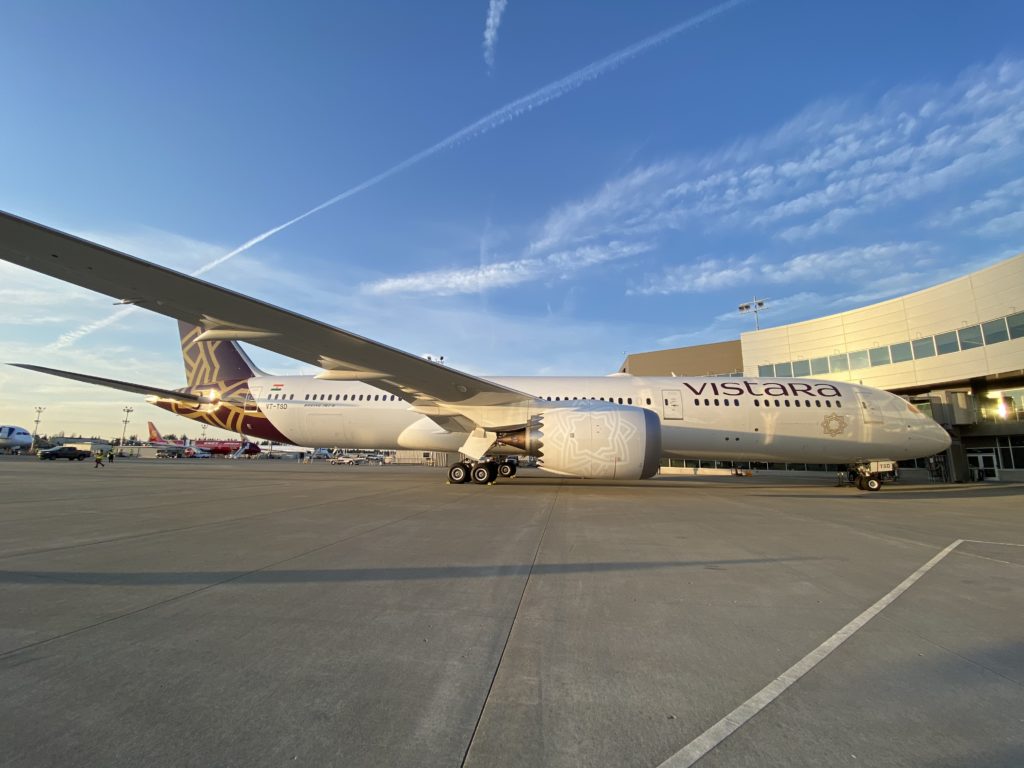
Vistara’s 787-9 is an essential step in the evolution of the airline, and many things matter on this order. First, Vistara went for a small order of 6 with four purchase rights, indicating they are in no rush to scale up international operations to places far away. Second, they chose equipment that could run multiple types of missions for them, from 4-6-16 hour flights. However, for the first six aircraft, which will be delivered by March 2021, the airline has worked out a configuration that allows for them to fly these aircraft for a maximum of an 8-10 hour long mission.
Reason? They skipped the crew bunks. There are defined guidelines for how long flight crew and cabin crew, who are primarily there for your safety, can stay alert. On ultra long haul flights, more crew travel, with some of them resting while others take charge of the cabin to ensure that the alertness of the crew is at its optimum levels when they are on duty. The range of these aircraft, then, is going to be about 8-10 hours, which allows Vistara to make flights to Japan on the east and United Kingdom on the west from Delhi Airport, where the first few jets will be based. Tokyo and London are both on the shortlist to be the first routes. Corona Virus and the ambiguity around London Heathrow slots though will put a little bit of a spin in their plans.
The Boeing 787-9 Dreamliner
Boeing launched the 787 Dreamliner as the route-opener, with the aircraft being worked in a way that it could eke out a profit for its customers on long and thin routes. That means the plane could fly very far (Qantas operates a London Heathrow – Perth non-stop for 16:45 hours with this same aircraft, the 787-9). However, economics could work for airlines which may not have too many customers on the flights every day (compared to, a Boeing 777, which usually carries over 350 passengers).
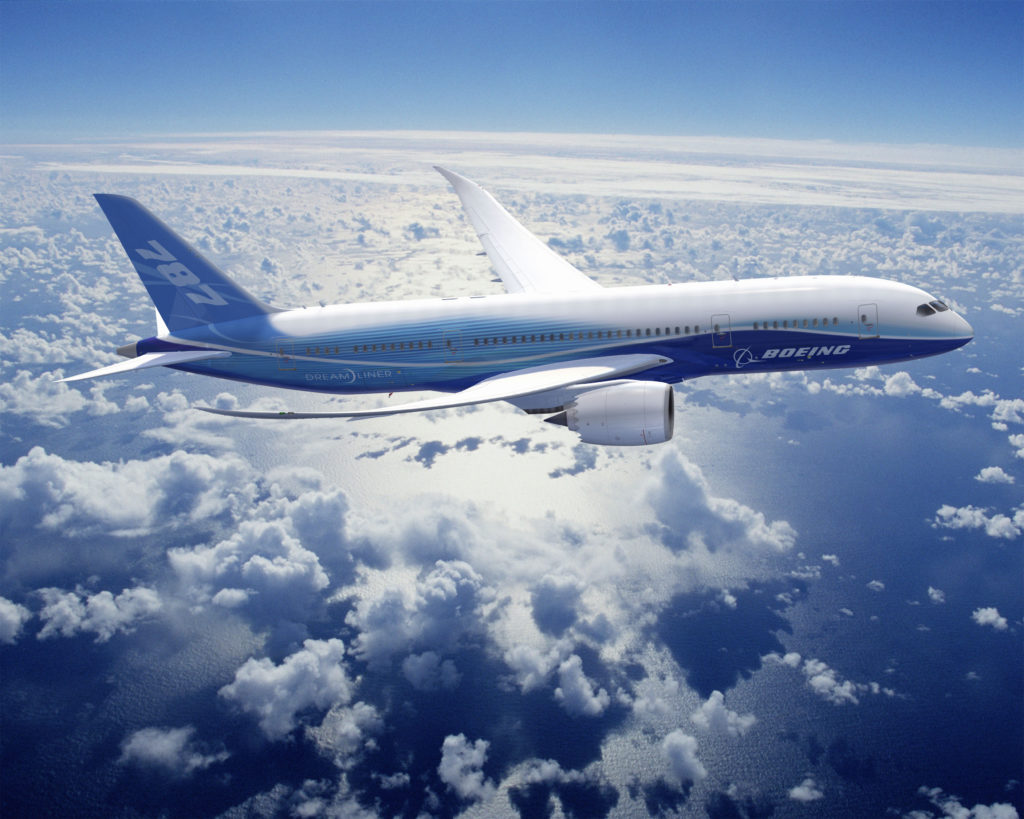
The 787 was the first aircraft to be constructed primarily of composite materials. The 787 was designed to be 20% more fuel-efficient than the Boeing 767, which it was going to replace. The 787s features include glass panel flight systems, raked wingtips, and noise-reducing chevrons on its engine nacelles. In making this aircraft, Boeing went with a collaborative approach, with components being manufactured outside the USA and not mainly on Boeing premises, primarily a model followed by Airbus. Final assembly takes place at the Boeing Everett Factory in Everett, Washington, and at the Boeing South Carolina factory in North Charleston, South Carolina. As of January 2020, the 787 had orders for 1,485 aircraft from 72 identified customers
The Boeing 787-8 was the first variant to be launched, followed by the 787-9 and 787-10. The Boeing 787-9 variant is 20 feet (6.1 m) longer and can fly 450 nautical miles (830 km) farther than the -8. The further stretched 787-10 variant, 18 ft (5.5 m) longer than the -9.
- The Dreamliner is made of 50% composite materials that are lighter and more durable than traditional aluminium. This enabled the aircraft to be lighter (fuel savings!) and made it possible for many new features to be introduced.
- The cabin pressure on the 787 is higher, and the humidity is more than other aeroplanes built with aluminium. Passengers onboard feel like they are at an altitude of 6,000 feet, which is a full 2,000 feet lower than other aircraft in service. You come out of the plane, feeling lesser fatigue and dry eyes/headaches. Not just that, with the 787, air conditioning systems are taken fresh from the atmosphere (not via the engines).
- The Dreamliner has windows that are 30% bigger than the on other similarly-sized aircraft. Not just that, the Dreamliner is the first commercial plane to have electronic dimmers at each seat. Unfortunately, this gives flight attendants control on all the shades automatically, so they can, for instance, dim all the windows in one go for a more extended phase of flight.
- The 787 is 20% more fuel-efficient than other aircraft that came before it, which allows airlines to operate on longer routes with lesser passengers and still make money.
- The Dreamliner also has a more evolved flight deck, with many buttons gone and controls moving to screens (called a glass panel cockpit). The aircraft also brought along a Heads Up Display, which displays essential information in the line of sight of the pilot so that they don’t have to alternate between looking outside and looking at the controls.
Vistara’s 787-9 Configuration
Vistara was always going to configure their aircraft in a 3-class configuration. This has been adequately reflected in their domestic aircraft configuration for years now. What we always also knew was that this was going to be Business Class, Premium Economy and Economy Class. First Class has been a diminishing trend for years. Like one has seen with Air India and Jet Airways, usually empty, First Class is being used to accommodate VIPs for free or upgrades when business and economy would be full. Otherwise, First Class is just flying weight on Indian carriers with no revenue generation potential in the current era.
Vistara went for the following configuration on their Boeing 787-9 aircraft for the long-haul missions:
- 30 Business Class seats in 1-2-1 configuration, between doors 1 and 2.
- 21 Premium Economy seats in 2-3-2 configuration, behind the Door 2 Galley.
- 248 Economy seats in 3-3-3 configuration
With the 787, Vistara has swapped their A320 colour scheme front to back, with the front of the aircraft getting the grey seats and the back of the plane getting the aubergine seats.
Vistara 787-9 Business Class
I am not sure if there is any branding that will follow the Business Class of Vistara, a-la-Upper Class for Virgin Atlantic and Premiere for Jet Airways, but Vistara’s 787 Business Class has been one of the most often asked question to me for a while. We finally got to see the Vistara Business Class, and it turns out Vistara is using the same seats that Singapore Airlines introduced on the Boeing 787-10, the Stelia Aerospace Symphony. Singapore Airlines worked with Stelia Aerospace to modify an existing concept called Solstyce, adding on the privacy shell. Besides Singapore Airlines, Vistara and Turkish Airlines now have them on their aircraft. Here is the Business Class, on delivery.
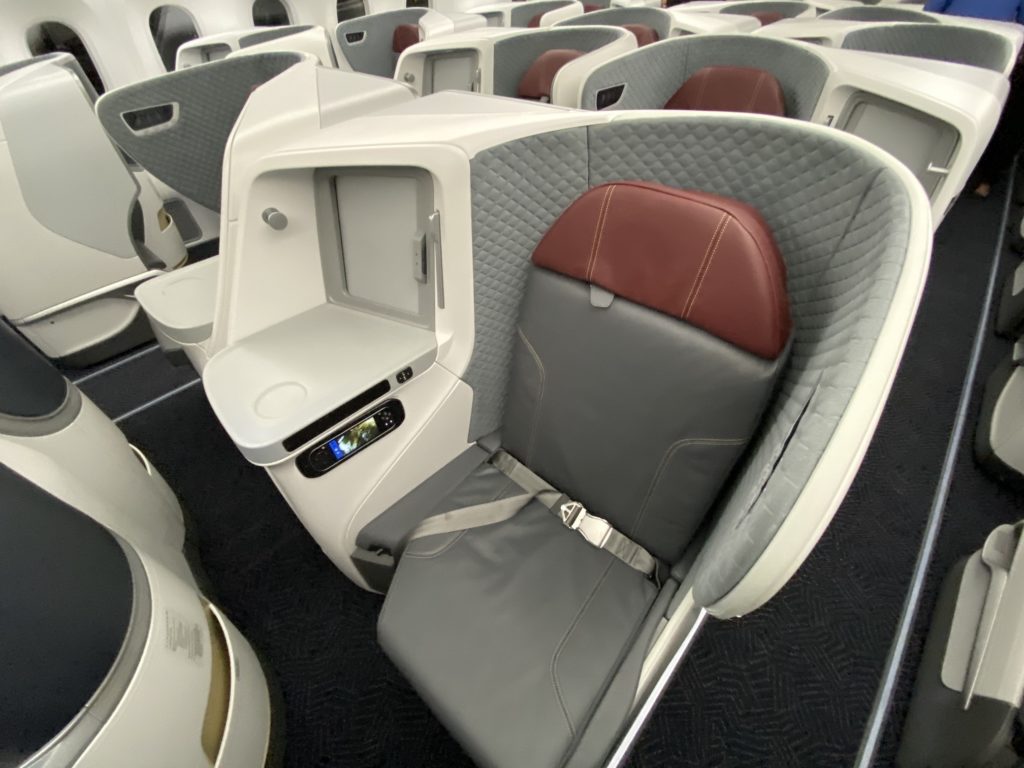
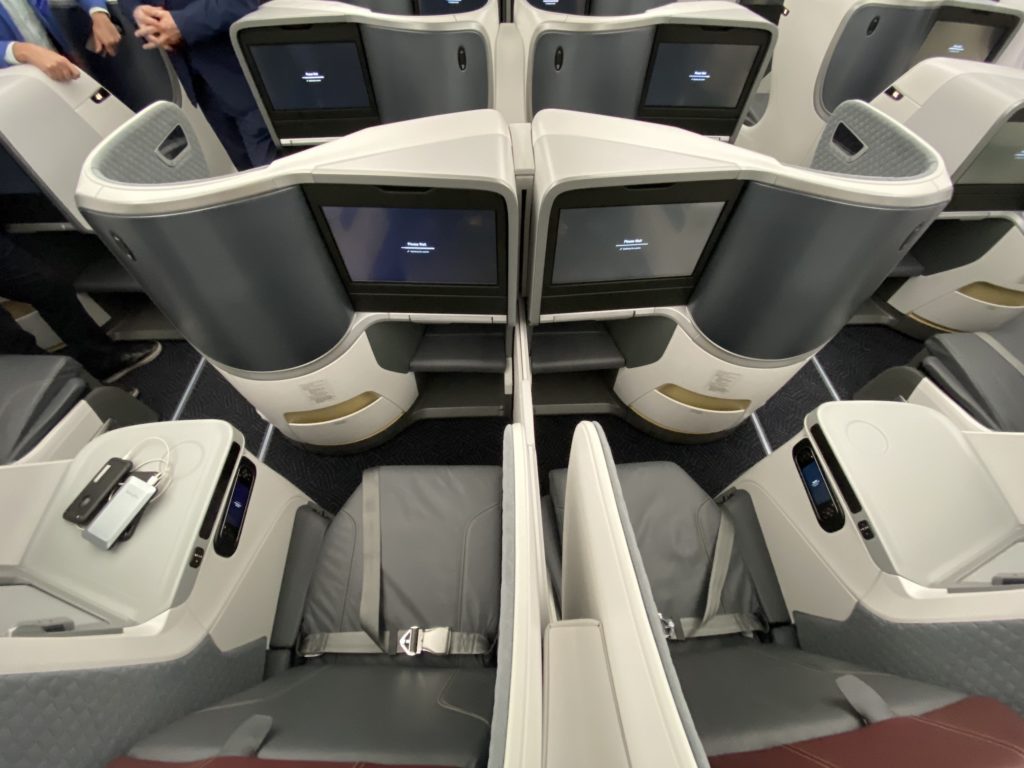
The seat has a 44″ seat pitch with a full flatbed with 76″ length. You can stow your small bags under the cubby. The cubby has enough space for side sleepers to sleep on the side. That is my natural position, and I usually find space enough.
 There is a small cabinet next to the cabin headrest on the seat, with a universal charging outlet along with a USB. The headsets will be found outside, and there will also be space to keep your passports, glasses and other small personal items along. For instance, you can leave your phone to charge here. There is also a vanity mirror for the quick touchup before landing.
There is a small cabinet next to the cabin headrest on the seat, with a universal charging outlet along with a USB. The headsets will be found outside, and there will also be space to keep your passports, glasses and other small personal items along. For instance, you can leave your phone to charge here. There is also a vanity mirror for the quick touchup before landing.
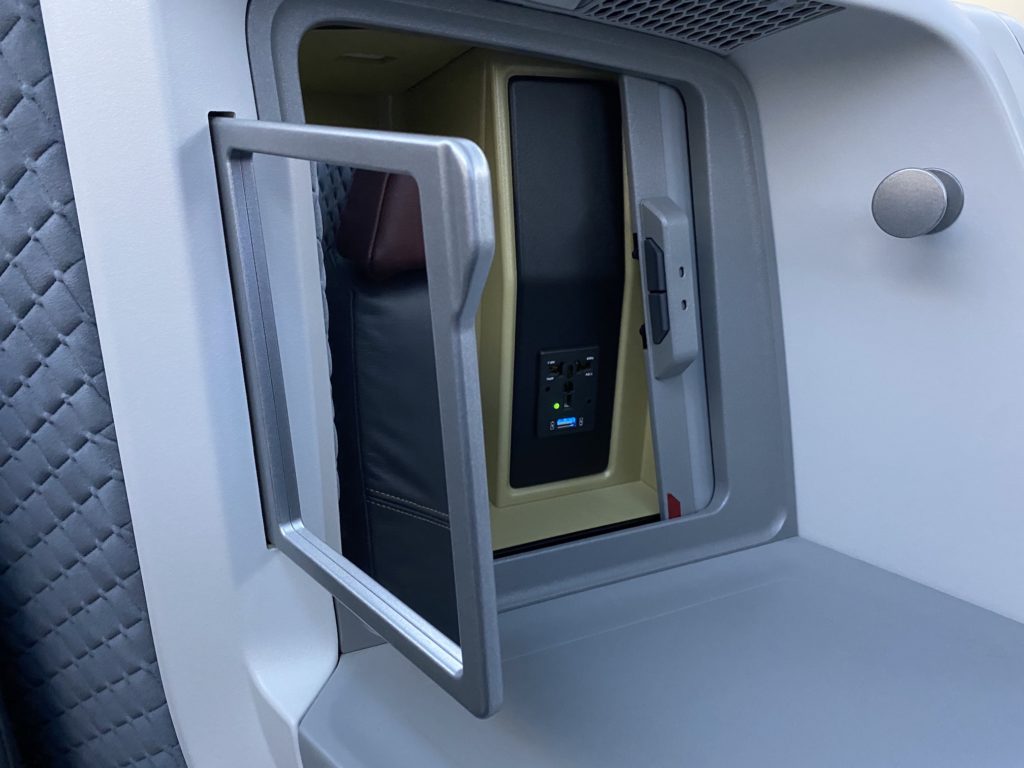
The finish is in grey leather, with the red accents as in the storage areas and cushions. The privacy cocoon works with a velvet lining on the inside and fitted with a reading lamp at all angles (takeoff, lounging, sleep). You can also have them all on at once. The privacy cocoon, provides additional privacy, even for aisle-exposed seats.
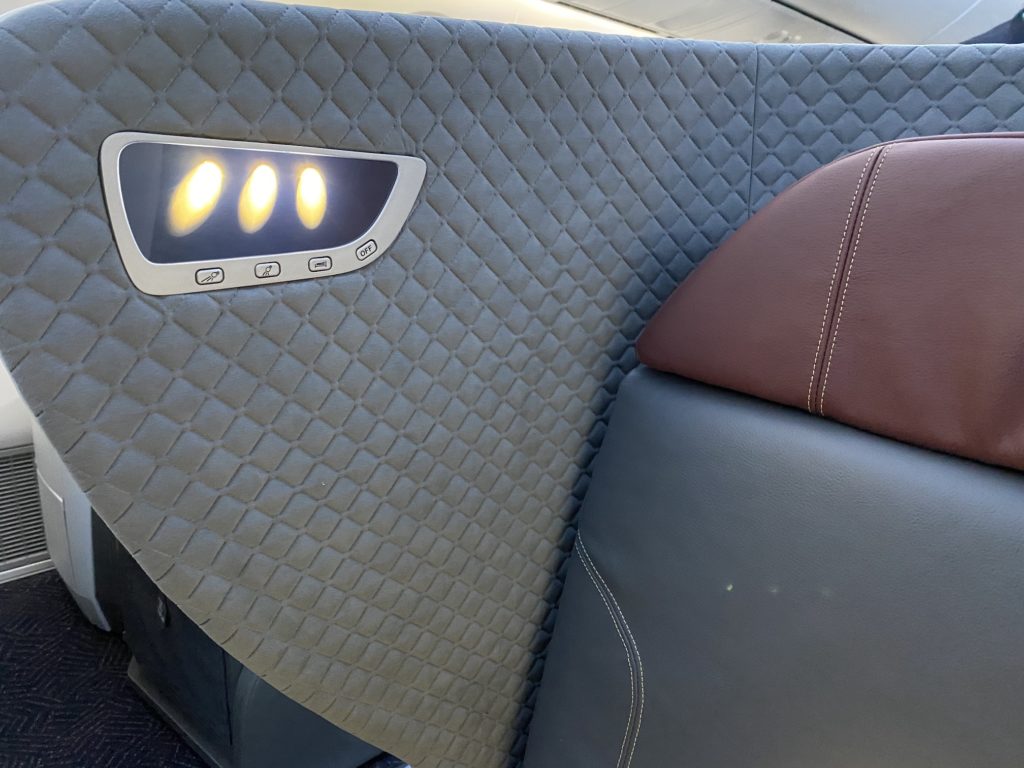
There is also an 18″ IFE monitor, which would serve you up content from the new Panasonic system that Vistara has installed. We could not witness the IFE system at delivery because upgrades were being installed at the time of our visit on the plane.
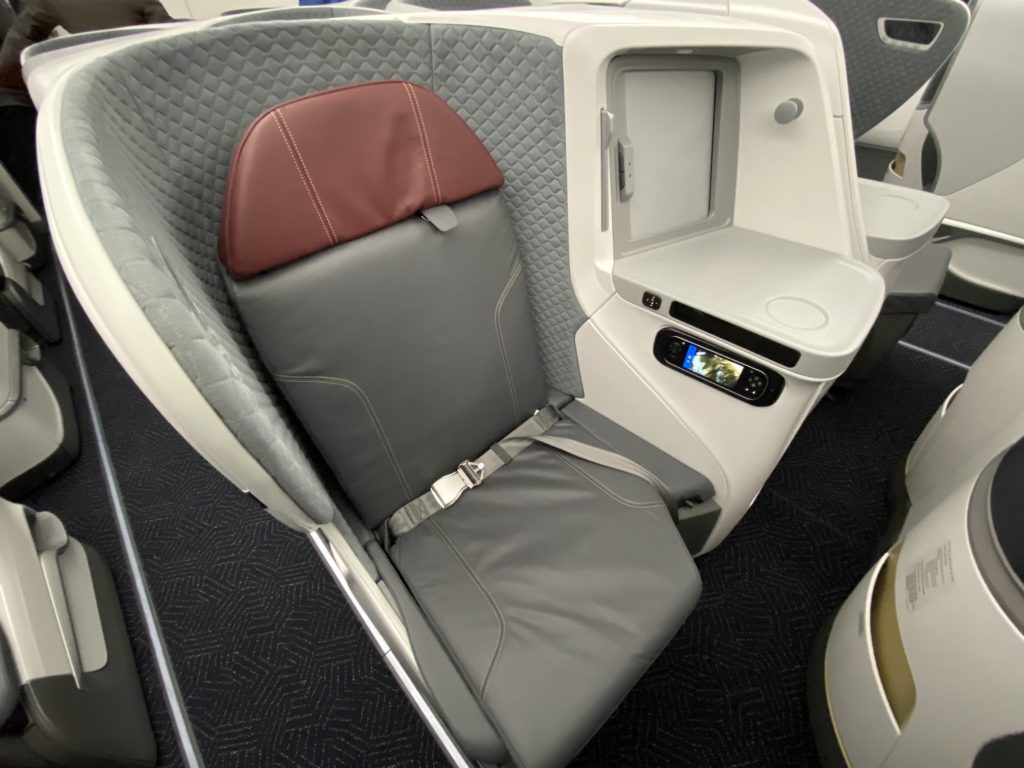
The chosen layout has 4 of the eight middle seats organised as solo seats, and four held for couples, directly arranged for seating next to each other. Although, even then, one would have to be coming forward of the privacy cocoon to have a chat. There is a privacy divider in case you get on to the couple seat and are flying solo. 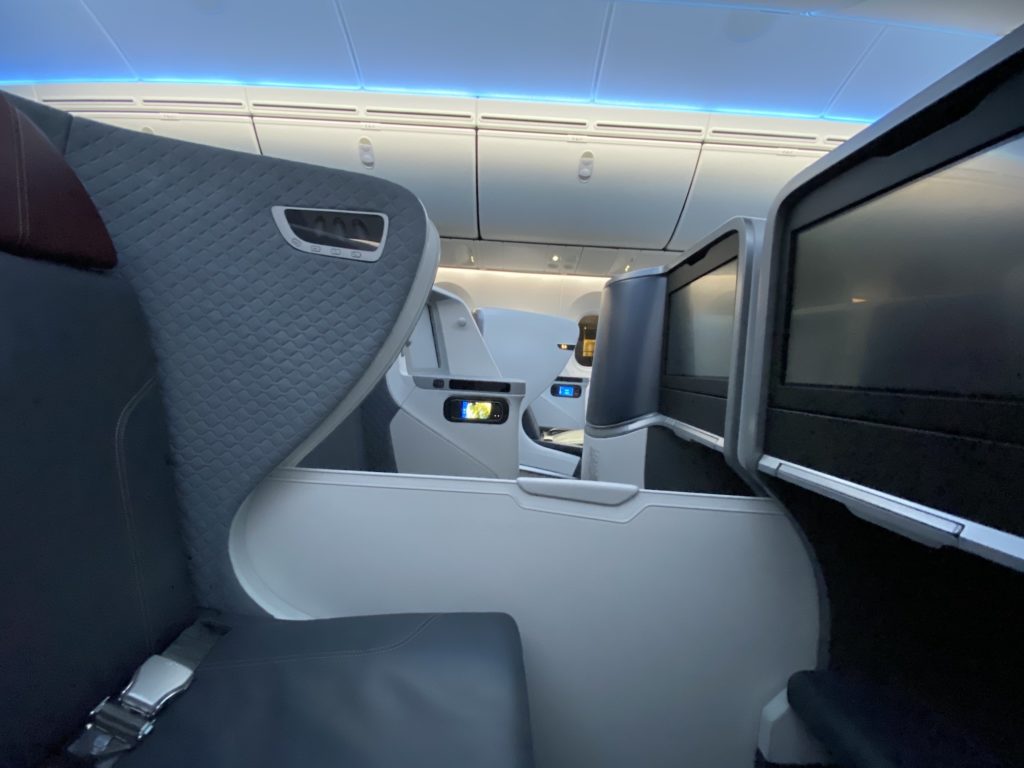
For solo flyers in business class, passengers will get to choose. There are the seats on the window side, but you can choose to be on the aisle side with the console next to the window. Or you can have a better view of the window and the console be on your aisle. Both have good privacy, and you get at least one full window for looking outside.
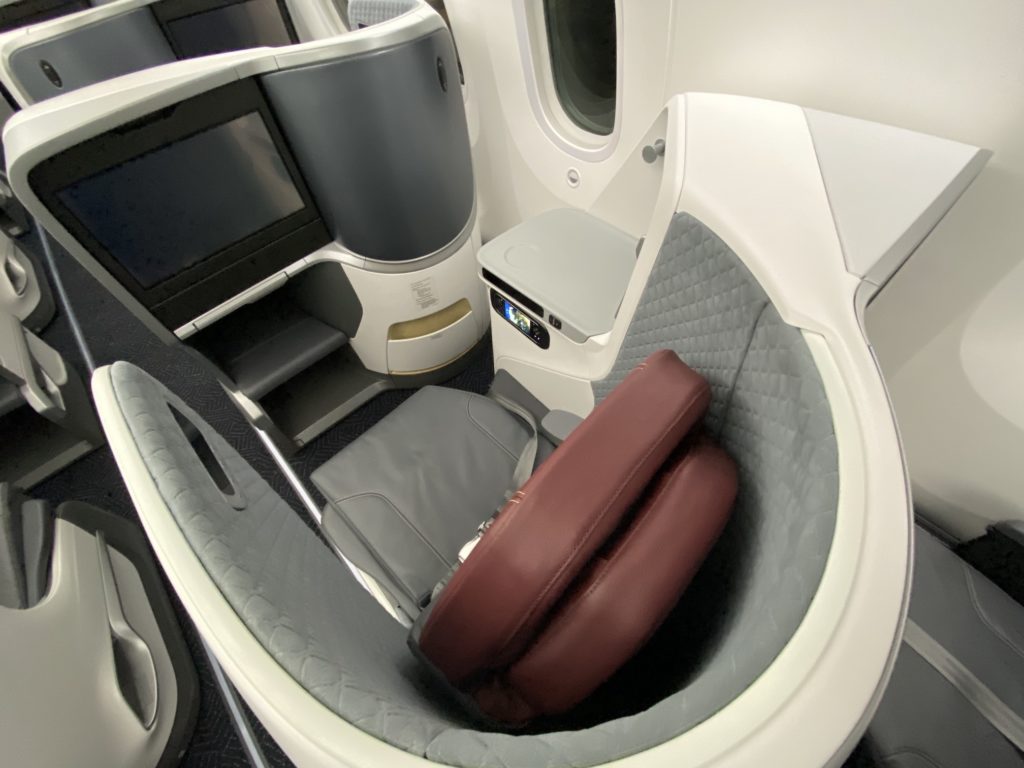
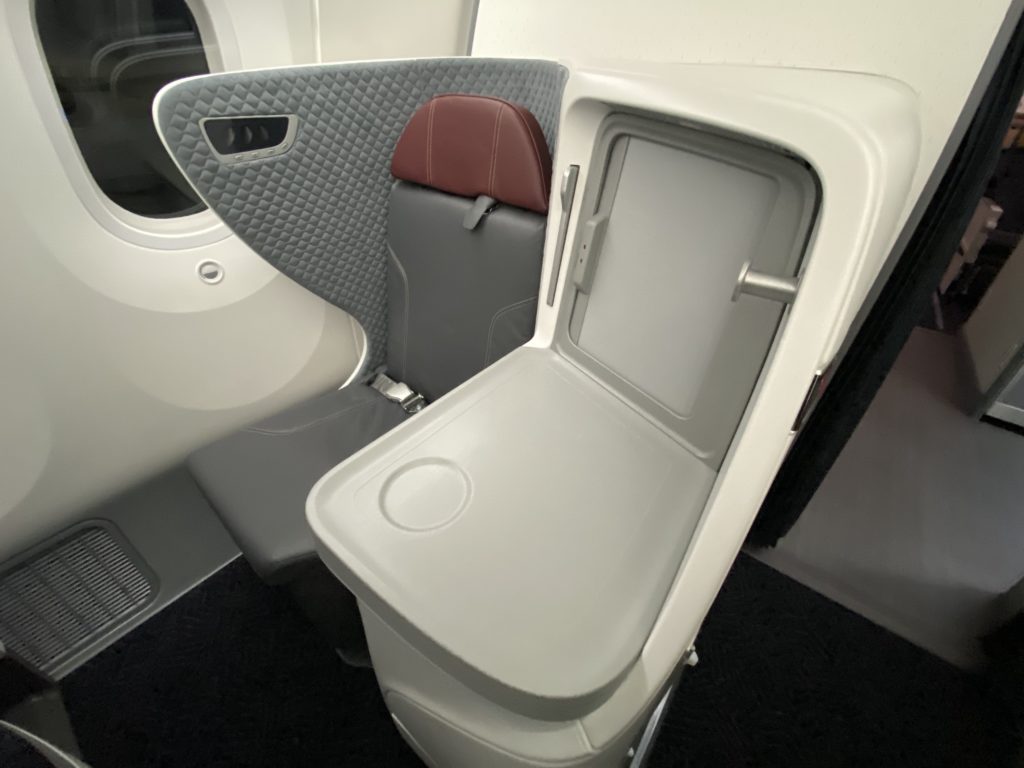
Some people have reported these seats to be a bit claustrophobic in the lie-flat mode because the walls close in, however, in my personal experience of this seat on the Boeing 787-10 of Singapore Airlines, I did not face any such issues. You can read my review of the 787-10 flight for more details. Also, there seems to be a lot of pre-set notion with SQ choosing this seat for their regional product. Singapore Airlines’ regional routes are at 8 hours, given their long-haul flights go all the way to 17-18 hours too.
People who are wondering that @airvistara selected the same seat @SingaporeAir uses on their B787-10 with regional operations; remember, SQ is using a long haul plane and product for medium haul. Does not mean that Vistara has to do the same. #paxex #ExperienceTheDream pic.twitter.com/vm7DBnJU03
— Ajay Awtaney (@LiveFromALounge) March 2, 2020
There has been much chatter about this, but for Vistara, which plans to operate this aircraft on an 8-10 hour flight then, this could be a good option. How will it pan out though, we will see the feedback when the plane is put into active international service. I’ve also seen feedback from some Singapore Airlines fans that this seat is very SQish. Well, try telling that to Turkish Airlines, and they won’t like the comparison I’m sure.
Here is a quick sneak preview into how the cabin will look all dressed up when it is commissioned into flight. 
Vistara 787-9 Premium Economy
Vistara went with a 2-3-2 configuration for their Premium Economy cabin, which was slightly lesser than my estimate of 2-4-2. Maybe I did not factor in fuselage width during the time of my computation, or maybe Vistara went for comfort, but 2-3-2 is a nice configuration for a Premium Economy, especially fresh in my head after I flew the Boeing 777 in a 2-4-2 configuration on my way back from Seattle.
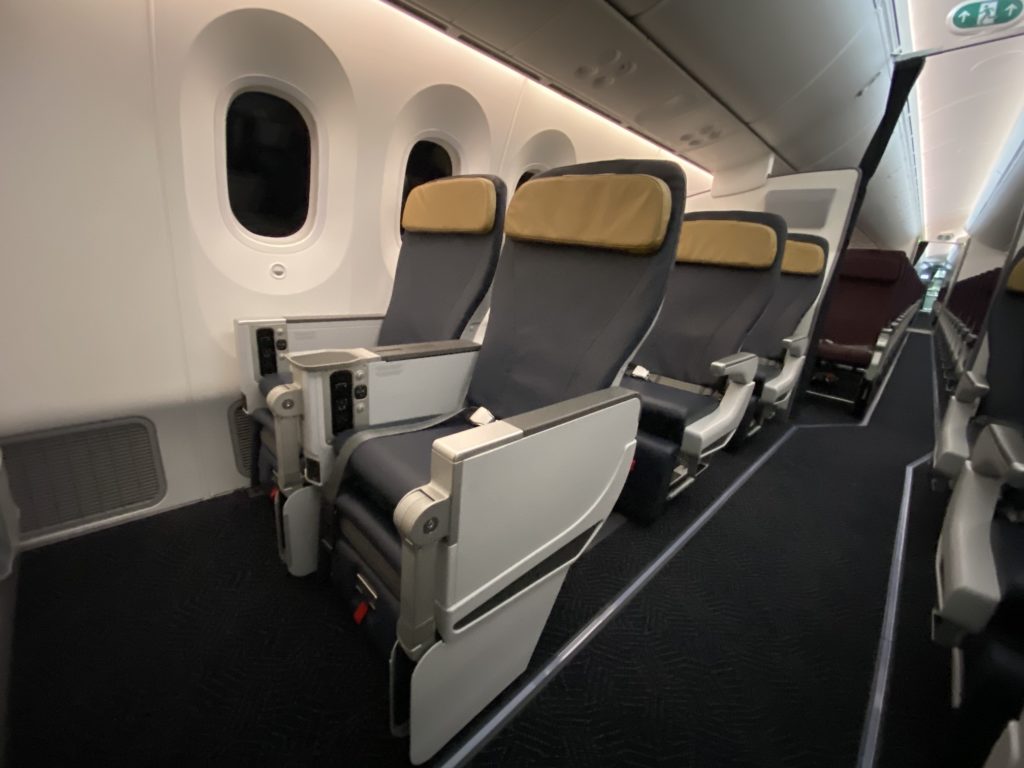
In my view, Vistara’s 787-9 Premium Economy is the star of the plane. Pay a bit more than the Economy, and you get a much bigger and roomier cabin than Economy, where the F&B experience will be much better than the Economy cabin as well. Vistara went for the Recaro PL3530 seats for their Premium Economy cabin.
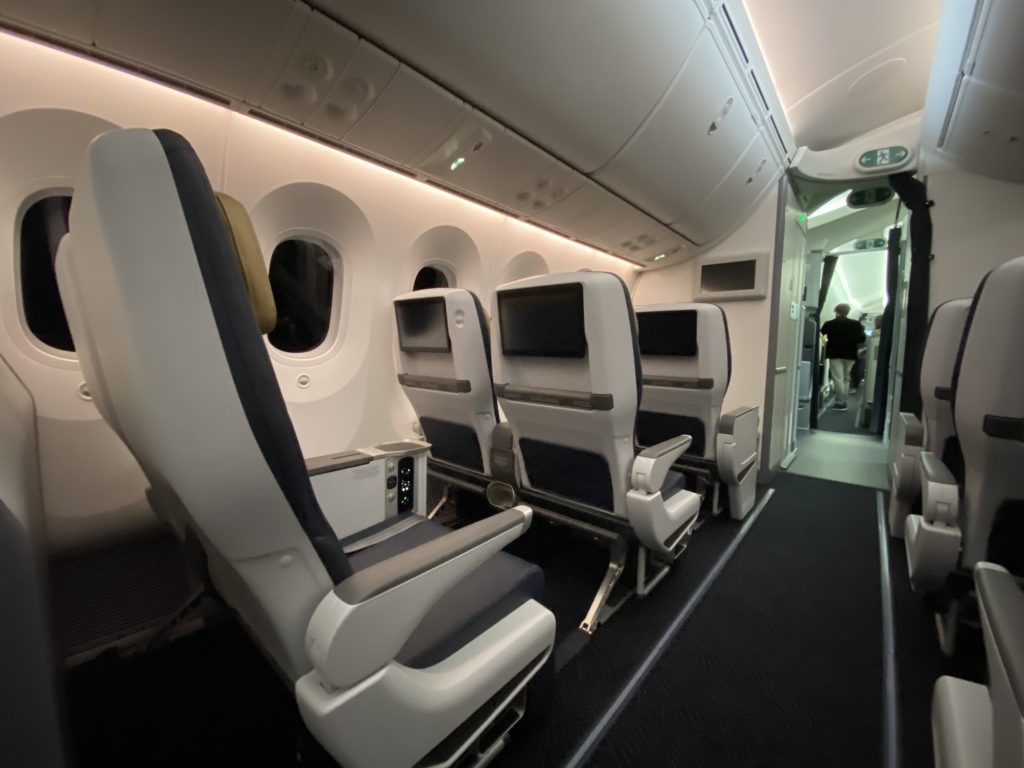
The PL3530 premium economy class seat sets the standards for comfort and functionality through its ergonomic shape, flexible equipment options and generous space. Its main comfort features include the individually-adjustable calf rest, seven-inch reclining backrest, and six-way adjustable headrest, which create a relaxed atmosphere for long-haul passengers. The ‘relax’ position is extremely comfortable and allows a pleasantly relaxed sitting position. The calf rest is individually adjustable, which is a significant plus, especially for taller passengers.
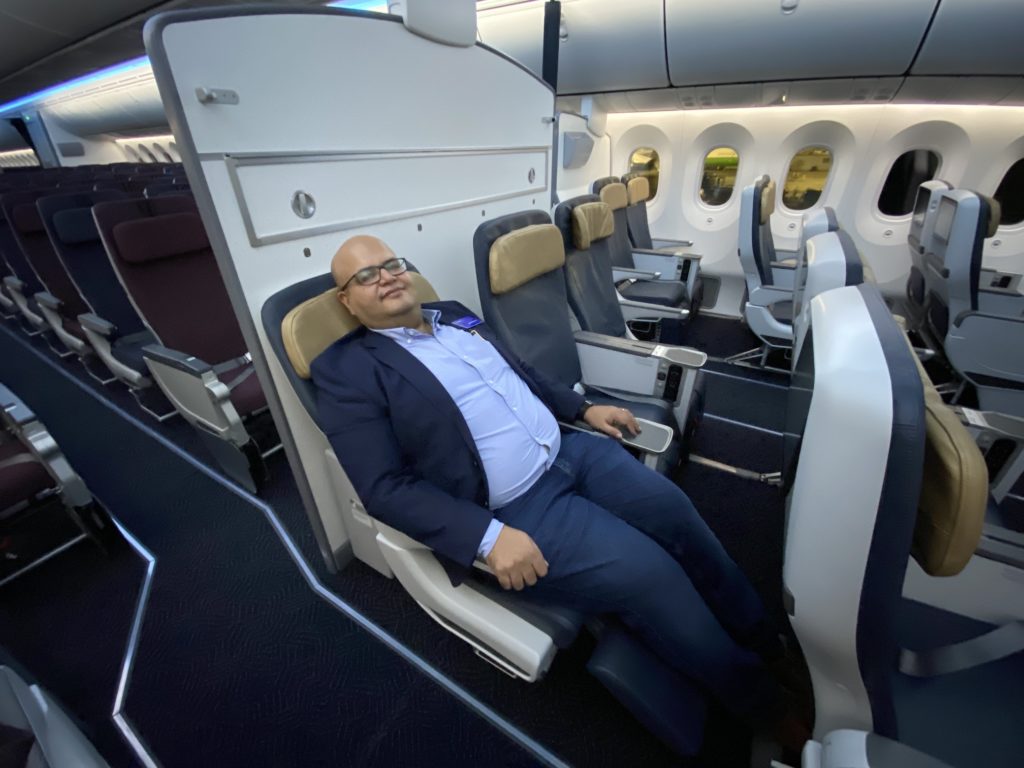
The large tray table, plentiful storage space, and an integrated entertainment system also improve the overall passenger experience. Vistara’s PE has a 13″ IFE screen, and while the seat pitch is 1″ lesser than the usual (most airlines with PE have a 38″ Seat Pitch), it was very comfortable. Two people can comfortably share the centre console’s armrest. I think this will be a business class experience in Premium Economy.
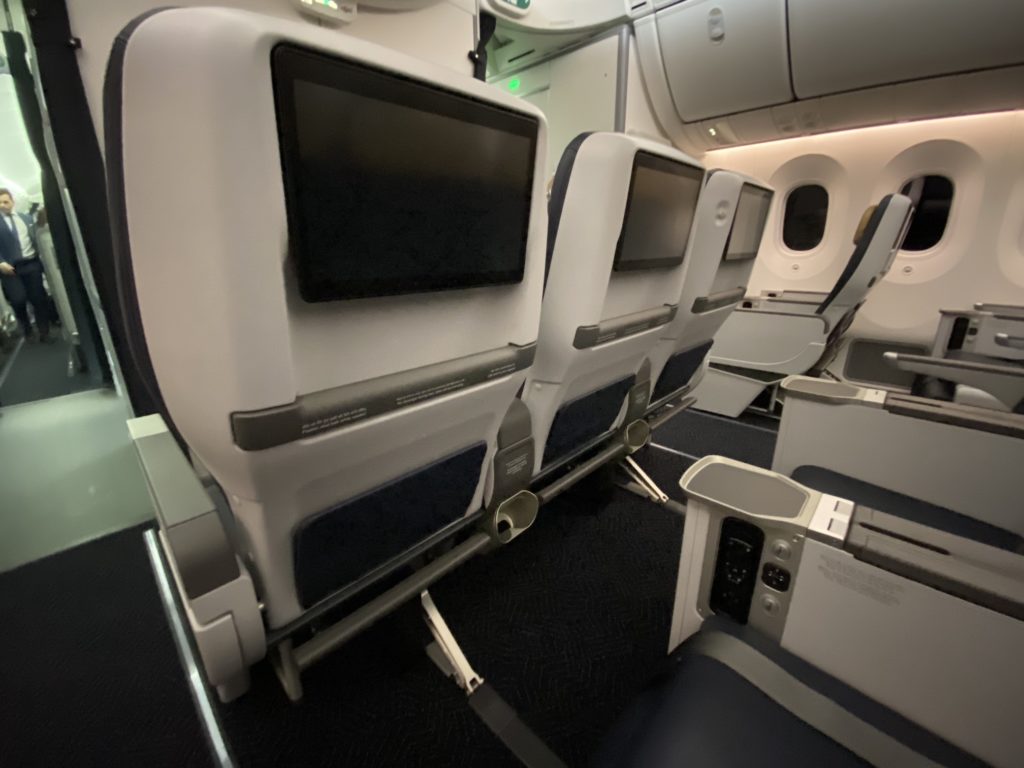
Here is a preview of the cabin all dressed up.
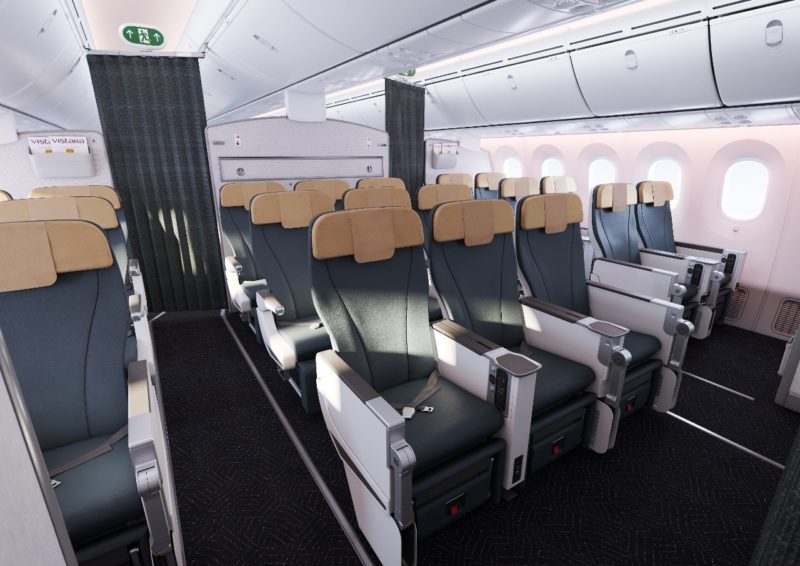
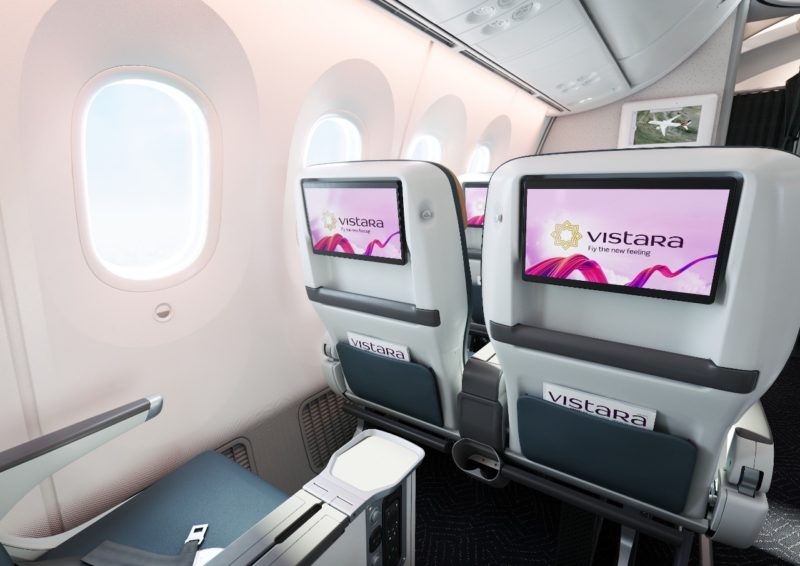
Vistara 787-9 Economy Class
Coming to the part where most of us will travel. Vistara went with some brilliant colours for their Economy class, and there are 248 seats in Vistara’s Economy Class, which is configured in a 3-3-3 configuration. Unlike the other Boeing 787 operator in India, Vistara’s colour scheme is a more formal and subdued one, but that also means if you spill coffee on a seat, it won’t be readily noticeable.
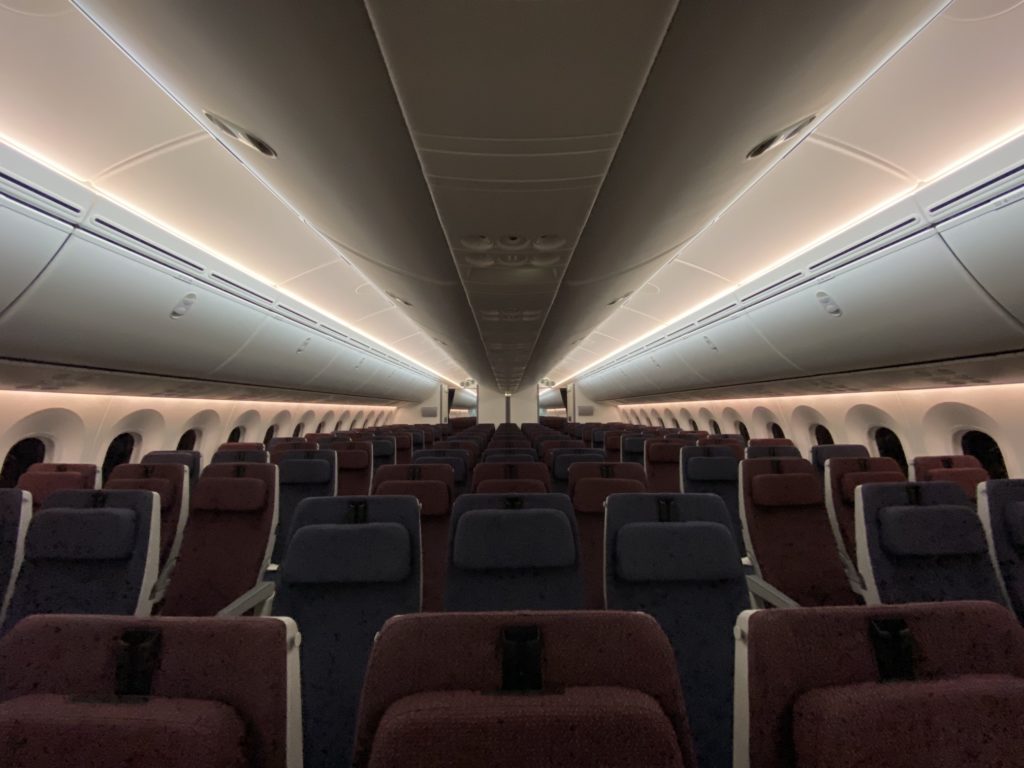
Vistara went with the Recaro CL3710 economy class seat. The modular design gives it the lightest weight in its class without compromising on comfort. With features such as the six-way headrest, high literature pocket, and easily-accessible power ports, Vistara will be able to make sure you travel in comfort, sleep well on this Economy cabin, and don’t crush your knees into the person ahead of you. The seat debuted just about a year ago and was launched with TAP Portugal.
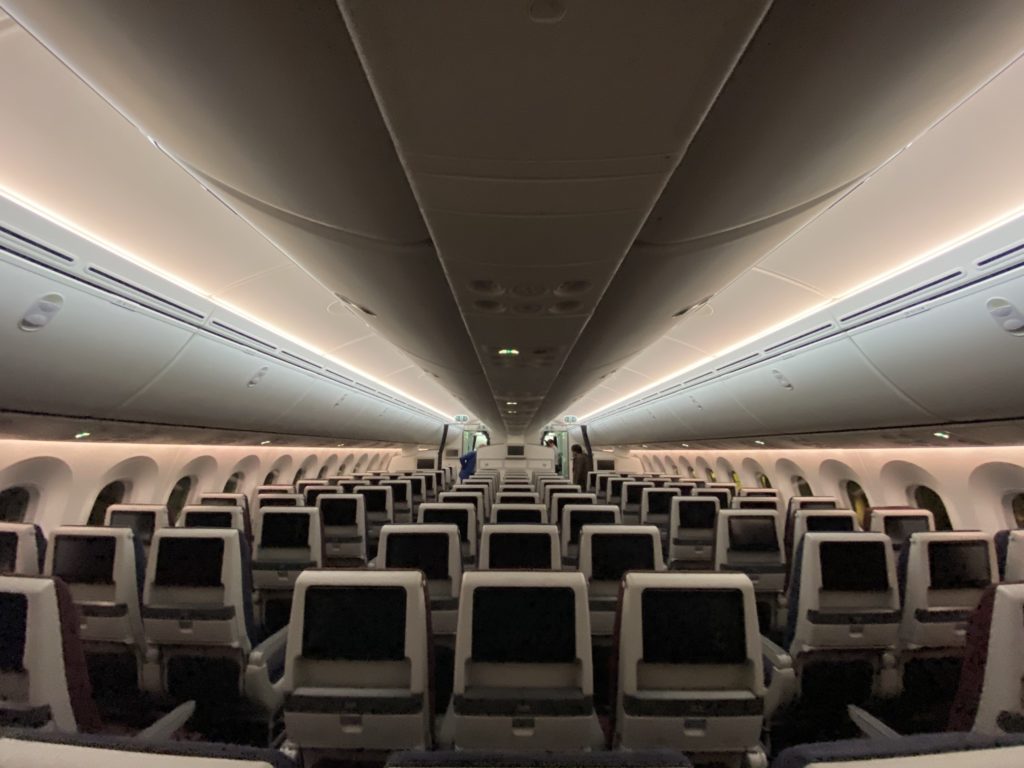
The seat has enough going for itself. Everyone gets a 12″ IFE screen and a USB charging port, and between a set of 3 seats, there are two power ports for sharing. The seat pitch is at 31″. There are also multilayered pockets which means you can keep your pens and spectacles in the smaller pockets, more easily accessible than some of the other stuff such as a water bottle you may put in the back.
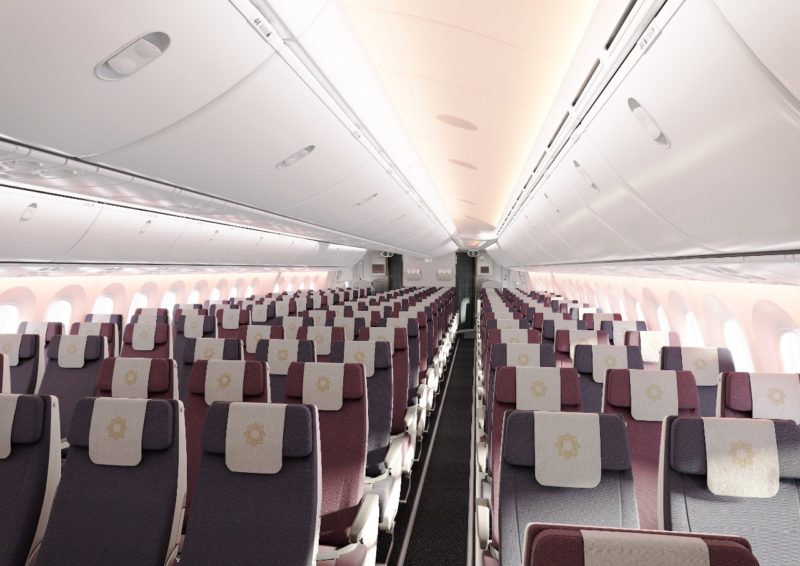
Vistara 787-9 Entertainment
Vistara will HD displays across the three cabins and will offer nearly 150 movies spanning Hollywood, Bollywood and Indian Regional languages. They will also have close to 500 short programmes and 2000 soundtracks from various genres. The IFE system will operate in English, Hindi, Simplified Chinese and Japanese to start.
Overall, with the roomier cabin of the 787, Vistara has walked the tightrope with maximising the number of passengers who can be accommodated with creating three distinct products as well. Before Vistara, only Jet Airways has worked on cabin distinctions, with Air India going with the standard Boeing offering from the start. Here is a walkthrough of the entire Vistara cabin in a video launched on the LiveFromALounge Youtube Channel.
What do you make out of the new Vistara 787 interior? Vistara has worked on a lot of other unique features as well, which I will cover in a later post.
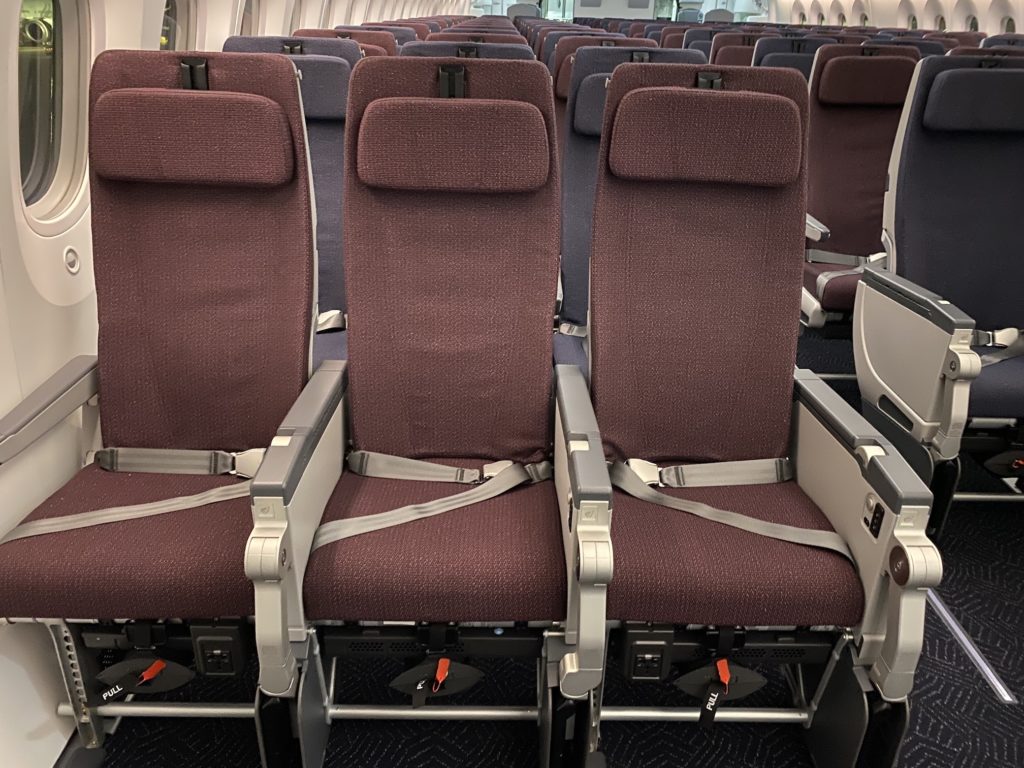

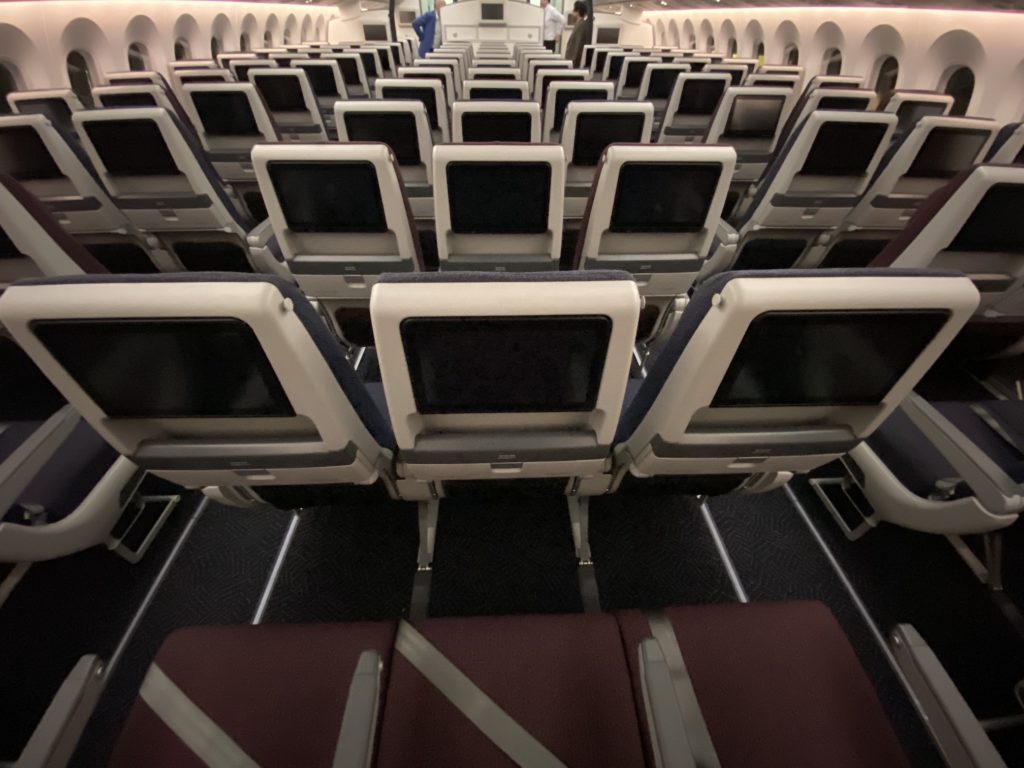



Thanks for this very informative review! Do the bulkhead seats in economy class each have their own IFE systems?
By looking at Vistara Business Class on 787 – I still believe Air Canada Business Class on 787 is more functional
Atleast Vistara managed to seperate the PE cabin from Eco cabin. This definately adds to premium feeling, something which LH just does not get it. If are combining this with premium yet soothing mood lightning, neat, clean and tidy cabins and welcoming on-board music, then they have already won the customer with initial impression.
I am not sure if they have stepped up catering service in PE, but if not then it should definately be considered with perhaps larger portions of main meal and serving an extra side dish. Serve premium snacks such as sandwiches or something filling rather than giving away packed snacks (dead food). Serve welcome drink such as juices or simply water. Small details, goes looong way to make passenger feel at home. Remember, thats also the motto of it’s giant sister.
Keep upgrading IFE systems and make sure the screens are responsive. I believe the rest is in the hands of cabin crew. They can really make or break the airline. Look at Air India.
Being a MileagePlus hoarder, I’ll be thrilled if they fly to Japan! Will probably free up my Avios for more westward travel.
Broadly, Vistara has played safe with the 787-10 by emulating SIA as closely as they can and hence have ticked the boxes. However the product lacks innovation both in terms of passenger comfort and productivity (space optimisation).
Even though the Stelia Solstyce is not a bad seat by any means there were better options for Vistara to consider. Granted they wanted an efficient configuration that could be competitive in terms of passenger experience considering premium fares out of India are low yield and possibly cannot profitably support products like Qsuites or Delta one suites, I somehow feel there are better products out there that can offer the same or higher level of efficiency and offer more space and comfort to passengers.
Americans Super diamond offer the same seat efficiency- 30 seats in the same cabin footprint as Vistara while offering a wider seat- this seat has been well received on a number of carriers such as Air Canada.
The Recaro CL 6710 flown by El Al is remarkably similar to United Polaris and fit 32 seats in the same space- something that Vistara could have considered. It also offers a marginally wider seat and feels less claustrophobic.
It’s also worth noting that while SIA does fly the 787-10 on 8 hour missions, the majority of its routes will be on sub 5 hour flights between Singapore and SEA destinations. Ominously, Turkish Airlines has had such negative feedback on these seats on its long haul 787s due to the constraining width that it is reconsidering the seat within a year of launch.
All in all the Vistara business seat still offers above average comfort in terms of business class products between India and Europe however I don’t think it’s the best choice both in terms of experience and productivity. Perhaps SIA’s existing volume and relationship with the manufacturers could have been a deciding factor in Vistara getting favourable pricing.
Having flown in a very similar premium economy seat on Delta’s Mumbai New York service, I can attest by saying this isn’t a bad seat. It has good padding and 2-3-2 on PE will make it even more spacious versus the 2-4-2 on a 777. There is however one major flaw in these seats- the storage space. The compartment under the seat screen cannot be used for anything other then a pair of spectacles and the seat pocket at the knee is so tight that it cannot even store a water bottle.
On Delta’s Premium select passengers were visibly confused about where to keep their essentials and the water bottles were constantly flying on the floor from the relatively thin arm rests. Hopefully Vistara has integrated some water bottle holders on their version- a small detail that hugely impacts passenger comfort on Long haul legs.
In economy Vistara has gone in for a run of the mill seat- again fine considering the market dynamics. The 31 inch legroom is actually not bad for knees room considering the thin seat back. I flew on a similar seat on KLM and was shocked at the amount of knee room being six feet tall- they didn’t touch the front of the seat.
The challenge however begins when you stretch your legs all the way under your seat only to find yourself playing footsie with your neighbour in front. The seat base is not very long and that’s when you feel the 31 inch pitch. Sadly, however offering 33 inch seat pitch is not viable for most carriers unless your home market is Japan so Vistara haven’t done anything surprising here.
The seat width will be tight but that again is a limitation of the aircraft. There is no way Vistara could have operated an 8 abreast configuration like JAL.
Overall, Vistara’s 787-9’s hard product is competitive as per industry standards. It’s infinitely better then Air India’s hard product although some flyers in economy will prefer the generous legroom. All in all it’s not groundbreaking and perhaps was not meant to be. I do feel however that they had more options in premium economy and business however they probably chose the same products as their big sister keeping cost and time in mind.
Let’s hope they innovate their soft product to truly differentiate themselves.
The business class seats on the window side, with the seat toward the window would normally be my choice so as to be able to have the maximum distance from people walking in the aisle, and ease of looking out the window- however, in this case the “cocoon” wall with light appears to cover half the window and make it difficult to see out which is frustrating. Even if your seat is aligned such that you have two windows, one next to the cocoon wall and one further forward, you’d be stuck leaning very far forward to escape the cocoon wall. It is frustrating when airlines make these kinds of basic design mistakes.
The economy cabin colours reminds me of Qatar airways economy class
@Abhi, Qatars Economy is all red I believe. Their crew uniforms are both these colours though.